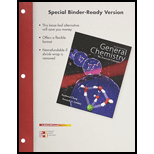
Interpretation:
The wavelength required to remove one electron from lithium atom should be determined.
Concept Introduction:
First ionization energy:
The ionization energy is the minimum energy required to remove the electron from an isolated atom which is in the gaseous state results to give gaseous ion with one positive charge.
Cation: Removal of electron from the atom results to form positively charged ion called cation.
The net charge present in the element denotes the presence or absence of electrons in the element.
In periodic table the horizontal rows are called periods and the vertical column are called group.
Plank-Einstein Equation: The energy is conversed property since it can neither be created nor be destroyed but can be transformed. The energy of the photon is obtained by using the following relation
Wavelength: The distance between the two continuous maximum displacements present in wave or the two continuous minimum displacements present in a wave exhibited by the photons is called wavelength. The wavelength of the photon is inversely proportional to its frequency. The relationship between them is given by the following formula,
Frequency: It denotes the number of waves passes in given amount of time.
The wavelength in
Answer to Problem 8.102QP
The wavelength required to remove the electron from the lithium atom is 230
Explanation of Solution
Determine the ionization energy for lithium.
The ionization energy for lithium atom is determined by using the given first ionization energy of the atom and converting it from
Determine the wavelength required to remove electron from lithium atom.
The wavelength required to remove the electron from the nucleus is obtained by dividing Planck’s constant and velocity of light with the energy of the wavelength which yields the value in meters that is finally converted to nanometers using the conversion that
The maximum wavelength required to remove an electron from the atom is determined by using the ionization energy.
Want to see more full solutions like this?
Chapter 8 Solutions
Loose Leaf Version for Chemistry
 ChemistryChemistryISBN:9781305957404Author:Steven S. Zumdahl, Susan A. Zumdahl, Donald J. DeCostePublisher:Cengage Learning
ChemistryChemistryISBN:9781305957404Author:Steven S. Zumdahl, Susan A. Zumdahl, Donald J. DeCostePublisher:Cengage Learning ChemistryChemistryISBN:9781259911156Author:Raymond Chang Dr., Jason Overby ProfessorPublisher:McGraw-Hill Education
ChemistryChemistryISBN:9781259911156Author:Raymond Chang Dr., Jason Overby ProfessorPublisher:McGraw-Hill Education Principles of Instrumental AnalysisChemistryISBN:9781305577213Author:Douglas A. Skoog, F. James Holler, Stanley R. CrouchPublisher:Cengage Learning
Principles of Instrumental AnalysisChemistryISBN:9781305577213Author:Douglas A. Skoog, F. James Holler, Stanley R. CrouchPublisher:Cengage Learning Organic ChemistryChemistryISBN:9780078021558Author:Janice Gorzynski Smith Dr.Publisher:McGraw-Hill Education
Organic ChemistryChemistryISBN:9780078021558Author:Janice Gorzynski Smith Dr.Publisher:McGraw-Hill Education Chemistry: Principles and ReactionsChemistryISBN:9781305079373Author:William L. Masterton, Cecile N. HurleyPublisher:Cengage Learning
Chemistry: Principles and ReactionsChemistryISBN:9781305079373Author:William L. Masterton, Cecile N. HurleyPublisher:Cengage Learning Elementary Principles of Chemical Processes, Bind...ChemistryISBN:9781118431221Author:Richard M. Felder, Ronald W. Rousseau, Lisa G. BullardPublisher:WILEY
Elementary Principles of Chemical Processes, Bind...ChemistryISBN:9781118431221Author:Richard M. Felder, Ronald W. Rousseau, Lisa G. BullardPublisher:WILEY





